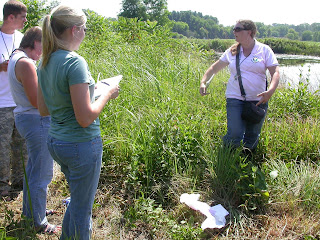Here are a few random glimpses of just a few of the people involved in botanical study in the Midwest. Special thanks to Scott Namestnik and Barbara Plampin for sharing pictures.
Justin Thomas and Scott Namestnik pause for a picture at Flat Rock Creek Heritage Preserve in South Carolina, May 2, 2011.
Ben Hess, Karen Quinlan, and Maria Shaffer take notes as Dana Thomas of the Institute of Botanical Training discusses wetland plants, St. Joseph County, Indiana, July 5, 2007.
Thismia hunters, Cook County, Illinois, August 13, 2011.
Paul Rothrock inventories plants at the Goose Pond Bioblitz near Linton, Indiana, July 16, 2010.
Tres amigos en la botanica: Brad Slaughter, Justin Thomas, and Scott Namestnik pause for a picture at Shut-in Mountain Fens, Missouri, April 21, 2010.
On the trail to Cave Spring, Missouri: Justin and Dana Thomas, with child Eli, Scott and Lindsay Namestnik, John and Bryn Scriver, with child Rilo. Also, Miss Bootypants. November, 2009.
Shirley Heinze Land Trust hikers after a ferns outing: Mr. and Mrs. Jim Erdelac, Mr. and Mrs. Noel Pavlovic, Laura Henderson, Terry Bonace, Myrna Newgent, Warren Buckler, Peter Grube, and Keith Board, Indiana Dunes State Park, July 23, 2011.
Noel Pavlovic and Tom Post at the Indiana Dunes, date unknown.
Emma Bickham Pitcher, banding a bird at the Indiana Dunes, date unknown.
Lois Howes explores what would later become "Howes Prairie" at the Indiana Dunes National Lakeshore, date unknown.
Scott Namestnik checks a small detail while sporting some pretty classy field duds at Old Stone Fort State Park in Tennessee, April 27, 2009.
Dan "The Orchid Man" McDowell photographs a Catalpa tree in flower, Gary, Indiana, June, 2005.
Justin and Dana Thomas, directors of the Institute of Botanical Training, take a break at Taum Sauk State Park in Missouri, July 21, 2007.
Photographer Pete Grube at work with Ragged Fringed Orchid and Grass Pink Orchid in Berrien County, Michigan, June 25, 2008.
Exploring the high dunes of Porter County, Indiana: Keith Board, David Hamilla, Barbara Plampin, Brad Bumgardner, and Peter Grube, Indiana Dunes State Park, July 24, 2009.
Planting a tree in memory of Jody Phifer: Beth Uhles, Gloria Gillies, Jodi's cousin (name unknown), Woody and Donna Feeler, Sandy O'Brien, and Myrna Newgent, Hobart, Indiana, July 9, 2009.
Tony Troche stops for a photo at Kaintuck Hollow, Mark Twain National Forest, Missouri, March 14, 2009.
Keith Board and Jerry Wilhelm at the Great Thismia Hunt, Cook County, Illinois, August 13, 2011.
An exhausted TNC burn crew, Ober Savanna Nature Preserve, Starke County, Indiana, April, 1990.
Barbara Plampin and Keith Board identify plants at the "Dritz Pits," Porter County, Indiana, circa 1991.
Jerry Wilhelm and Floyd Swink at work in the Morton Arboretum, Lisle, Illinois, 1974.
DNR botanist Mike Homoya photographs Lizard's Tail at Plaster Creek Seeps, Martin County, Indiana, June 27, 2009.
Kevin Tungesvick surveys plants at Beehunter Marsh near Linton, Indiana, July 17, 2010.
Justin Thomas, Theo Witsell, and Doud Ladd survey plants at Frog Hollow, Arkansas, April 23, 2010.
Theo Witsell surveys plants at Middle Fork Barrens, Arkansas, April 23, 2010.
Andrew Blackburn checks out buttresses on a cypress tree at Fakahatchee Strand Preserve State Park in Florida, March 13, 2004.
Tony Troche explores a glade at Carman Springs Natural Area, Missouri, March 15, 2009.
Vic Riemenschneider surveys plants at Bendix Woods County Park, St. Joseph County, Indiana, May 10, 2009.
Keith Board, Mike Homoya, John Ervin, and Roger Hedge pause for a picture at the Indiana Dunes National Lakeshore, Porter County, Indiana, June 24, 2008.
Peter Grube pauses for a picture in a sandy meadow near New Buffalo, Michigan, June 25, 2008.
Floyd Swink, Ken Klick, and Noel Pavlovic survey plants at the Indiana Dunes National Lakeshore, Porter County, Indiana, date unknown.
Scott Namestnik photographs the rare Western Wallflower at a gravel hill prairie in Tippecanoe County, Indiana, April 22, 2012.
Noel Pavlovic does a balancing act at Little Lake, Indiana Dunes National Lakeshore, date unknown.
Ken Dritz and Keith Board pause near a railroad in Chesterton, Indiana, after photographing Aegilops cylindrica, Jointed Goat Grass, circa 1998.

















,+Keith+Board(left).JPG)






















